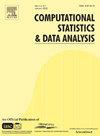部分形状约束标量函数线性回归模型的统计推断
IF 1.5
3区 数学
Q3 COMPUTER SCIENCE, INTERDISCIPLINARY APPLICATIONS
引用次数: 0
摘要
功能线性回归模型被广泛用于将功能/纵向结果与多个标量预测因子联系起来,通过回归系数函数识别时变协变量效应。除了评估统计显著性之外,表征系数函数的形状对于得出可解释的科学结论至关重要。现有的形状约束分析研究主要集中在全局形状上,这需要对整个领域的功能关系有严格的先验知识。这通常会导致由于缺乏先验信息而导致错误指定的回归模型,从而使它们在实际应用中变得不切实际。为了解决这个问题,引入了一个灵活的框架来识别回归系数函数中的部分形状。提出的部分形状约束分析使研究人员能够在目标子域内验证功能形状,避免对感兴趣的子域外的形状约束的错误说明。该方法还允许测试不同子域的单个协变量和跨复合子域的多个部分形状约束。我们的框架支持基于核和基于样条的估计方法,确保了健壮的性能和灵活的计算偏好。跨各种场景的有限样本实验表明,所提出的框架在估计和推理过程中都明显优于局部域的全局形状约束应用。推理工具特别将I型错误率维持在名义显著性水平上,并随着样本量的增加而显示出越来越大的功率,从而确认了测试程序的一致性。部分形状约束推理的实用性通过两个应用得到了证明:一项针对a型抵抗性颈肌张力障碍的NeuroBloc临床试验和国家精神卫生研究所精神分裂症研究。本文章由计算机程序翻译,如有差异,请以英文原文为准。
Statistical inference for partially shape-constrained function-on-scalar linear regression models
Functional linear regression models are widely used to link functional/longitudinal outcomes with multiple scalar predictors, identifying time-varying covariate effects through regression coefficient functions. Beyond assessing statistical significance, characterizing the shapes of coefficient functions is crucial for drawing interpretable scientific conclusions. Existing studies on shape-constrained analysis primarily focus on global shapes, which require strict prior knowledge of functional relationships across the entire domain. This often leads to misspecified regression models due to a lack of prior information, making them impractical for real-world applications. To address this, a flexible framework is introduced to identify partial shapes in regression coefficient functions. The proposed partial shape-constrained analysis enables researchers to validate functional shapes within a targeted sub-domain, avoiding the misspecification of shape constraints outside the sub-domain of interest. The method also allows for testing different sub-domains for individual covariates and multiple partial shape constraints across composite sub-domains. Our framework supports both kernel- and spline-based estimation approaches, ensuring robust performance with flexibility in computational preference. Finite-sample experiments across various scenarios demonstrate that the proposed framework significantly outperforms the application of global shape constraints to partial domains in both estimation and inference procedures. The inferential tool particularly maintains the type I error rate at the nominal significance level and exhibits increasing power with larger sample sizes, confirming the consistency of the test procedure. The practicality of partial shape-constrained inference is demonstrated through two applications: a clinical trial on NeuroBloc for type A-resistant cervical dystonia and the National Institute of Mental Health Schizophrenia Study.
求助全文
通过发布文献求助,成功后即可免费获取论文全文。
去求助
来源期刊

Computational Statistics & Data Analysis
数学-计算机:跨学科应用
CiteScore
3.70
自引率
5.60%
发文量
167
审稿时长
60 days
期刊介绍:
Computational Statistics and Data Analysis (CSDA), an Official Publication of the network Computational and Methodological Statistics (CMStatistics) and of the International Association for Statistical Computing (IASC), is an international journal dedicated to the dissemination of methodological research and applications in the areas of computational statistics and data analysis. The journal consists of four refereed sections which are divided into the following subject areas:
I) Computational Statistics - Manuscripts dealing with: 1) the explicit impact of computers on statistical methodology (e.g., Bayesian computing, bioinformatics,computer graphics, computer intensive inferential methods, data exploration, data mining, expert systems, heuristics, knowledge based systems, machine learning, neural networks, numerical and optimization methods, parallel computing, statistical databases, statistical systems), and 2) the development, evaluation and validation of statistical software and algorithms. Software and algorithms can be submitted with manuscripts and will be stored together with the online article.
II) Statistical Methodology for Data Analysis - Manuscripts dealing with novel and original data analytical strategies and methodologies applied in biostatistics (design and analytic methods for clinical trials, epidemiological studies, statistical genetics, or genetic/environmental interactions), chemometrics, classification, data exploration, density estimation, design of experiments, environmetrics, education, image analysis, marketing, model free data exploration, pattern recognition, psychometrics, statistical physics, image processing, robust procedures.
[...]
III) Special Applications - [...]
IV) Annals of Statistical Data Science [...]
 求助内容:
求助内容: 应助结果提醒方式:
应助结果提醒方式:


